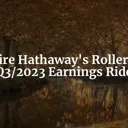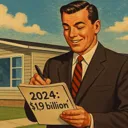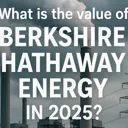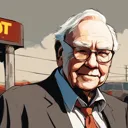Tags: Earnings / Share Buyback
This fanpage is not officially affiliated with Berkshire Hathaway: Disclaimer
Berkshire recently published its 2024 third quarter report on Saturday, November 2nd, 2024 8. Subsequently, the stock saw a drop of more than 2% on Monday, November 4th to around $442 per Class-B share 3. This "mini-crash" was no surprise. Again, Berkshire did not make any buybacks this quarter, hence it might be trading above intrinsic value. Let's have a look at the big picture.
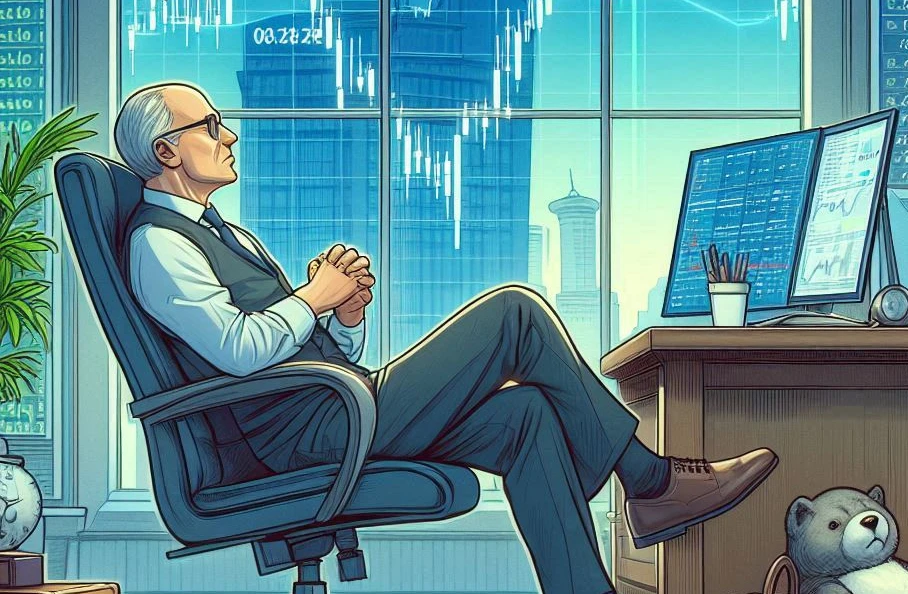
Introduction
In an (un)expected turn of events, Berkshire Hathaway experienced a notable 2% drop in its stock price on November 4, 2024, amidst a generally stable market environment 3. This sudden decline, which we may refer to as a "mini-crash," has piqued the interest of investors and market analysts alike, prompting a closer examination of the underlying factors. At the heart of this situation lies Berkshire's formidable financial strength, underscored by its substantial cash pile of $325.2 billion 1. However, the decision to halt buybacks during this period has added a layer of complexity to the market's reaction.
The role of market perception cannot be underestimated in this scenario. Investor psychology often plays a significant role in influencing stock prices, particularly for a company as closely watched as Berkshire Hathaway. The market's interpretation of Berkshire's strategic decisions can lead to volatility, as seen in this recent event. Historically, similar market reactions have unfolded when companies make strategic financial decisions, leading to fluctuations in stock prices. Drawing parallels to previous instances, such as during the 2008 financial crisis, provides valuable context for understanding the current situation.
The purpose of this article is to delve into the reasons behind the stock drop, analyze Berkshire's strategic decisions, and explore the potential long-term implications for shareholders ↗. By posing questions about the broader market and shareholder impacts, we aim to engage readers and invite them to explore these themes further. In the sections that follow, we will provide a detailed analysis and historical insights to unravel the complexities of Berkshire's recent actions and their implications.
Strategic Decisions and Market Reactions
One of the pivotal strategic decisions made by Berkshire Hathaway was the halt on share repurchases in Q3 2024 1. This move signals to the market that Berkshire may perceive its shares as overvalued, prompting investors to reassess their positions. The decision to pause buybacks, coupled with a significant reduction in Berkshire's Apple stake by 67.2% 2, aligns with Warren Buffett's cautious market outlook. These actions reflect a broader strategy of reducing concentration and managing portfolio risk amid high valuations.
Historically, major investors selling large holdings have had profound impacts on market sentiment and stock prices. For instance, during the 2008 financial crisis, strategic stock sales by key players contributed to market volatility. In the current context, Berkshire's substantial stock sales, including the offloading of over $10 billion of its Bank of America investment since mid-July 1, have drawn parallels to these past events. On July 27th we asket if a Market Crash is Looming ↗ amidst a continuous sale of Bank of America shares. Subsequently, the stock fell from around $440 to around $410 again after the publication of Berkshire's second quarter report.
The market's interpretation of Berkshire's large cash reserves and strategic sales is further influenced by the historically high S&P 500 PE ratio of around 29 as of November 4, 2024 6. Such financial moves are often seen as indicators of an overvalued stock market, prompting investors to tread cautiously. Additionally, Buffett's concerns about potential tax rate increases on capital gains 1 add another layer of complexity to his decision-making process, as he navigates the evolving economic landscape.
Comparing analyst expectations for Berkshire's operating earnings with the actual figures reveals a 6% year-over-year decline due to weak insurance underwriting 1. This discrepancy highlights the challenges faced by the company in meeting market expectations. To provide a clear overview for readers, the following table summarizes some of Berkshire's key financial metrics:
| Financial Metric | Value |
|---|---|
| Cash Reserves | $325.2 billion |
| Share Buybacks | 0 |
| Stock Sales in Q3 | $36.1 billion |
| Operating Earnings (Q3) | $10.1 billion |
| Overall Apple Stake Reduction | 67.2% (!) |
So, what do we make of it?
Economic and Political Influences
The recent strategic maneuvers by Warren Buffett and Berkshire Hathaway have not occurred in a vacuum. They are deeply intertwined with a complex tapestry of economic and political factors that shape the investment landscape. Understanding these influences is crucial for shareholders aiming to navigate the current market turbulence.
Buffett's decision to reduce Berkshire's stake in Apple, a move that has intrigued analysts and investors alike, is partly motivated by potential changes in tax policy. With the U.S. government grappling with a climbing fiscal deficit, there is speculation that capital gains taxes could rise. Buffett himself hinted at this possibility, suggesting that selling now might preempt future tax hikes. This strategic foresight underscores the importance of tax considerations in investment decisions, especially when managing a portfolio as substantial as Berkshire's.
Historically, political events such as elections and policy shifts have had profound impacts on market behavior. For instance, the 2008 financial crisis was exacerbated by regulatory changes and government interventions. Similarly, the market's reaction to the 2016 U.S. presidential election highlighted how political uncertainty can drive volatility. As we approach another election cycle, investors are understandably cautious, mirroring Buffett's risk-off stance.
The current economic climate presents a mixed bag of indicators. Inflation projections are expected to fall below the Federal Reserve's 2% target by 2025, offering some relief to investors concerned about rising costs. Meanwhile, interest rates are projected to stabilize, with the federal-funds rate expected to be between 3.00% and 3.25% by the end of 2025. These factors suggest a cautiously optimistic outlook, yet they also highlight the need for strategic positioning in an unpredictable environment.
The S&P 500 is currently trading at a premium to fair value 4, a situation that has occurred only few times since 2010. This premium suggests that the market is somewhat overvalued, which can impact investor sentiment and decision-making. In such a context, Buffett's decision to hoard cash rather than pursue aggressive buybacks or acquisitions may reflect a prudent approach to avoid overpaying in a frothy market.
Comparing the U.S. economic situation with other global markets reveals interesting contrasts. While the U.S. grapples with fiscal deficits and potential tax changes, other economies may face different challenges, such as slower growth or more stringent fiscal policies. These differences can influence capital flows and investment strategies, as investors seek to balance risk and return across diverse markets.
The Inflation Reduction Act introduced a 1% excise tax on stock buybacks, a move that might have only slightly altered corporate strategies: US companies bought back shares for almost $800 billion (!) in 2023 9. For companies like Berkshire, which have historically used buybacks to enhance shareholder value.
To provide context for these discussions, consider the following key economic indicators 4:
- Real GDP Growth: Forecasted at 1.5% for Q4 2024 and Q1 2025, with gradual reacceleration in H2 2025.
- US 10-year Treasury Bond Yield: Expected to be 3.60% in 2025, decreasing to 3.00% by 2027.
- Federal-funds Rate: Projected to range from 3.00% to 3.25% by the end of 2025.
However, given the huge US budget deficit, even the estimated lowering of the treasury rates might not be sufficient. As outlined time and again, these factors including an anticipation of increased company taxes might have been a significant incentive for Berkshire to sell large parts of its portfolio. Let us have a look again at the implications of the current share buyback strategy.
Share Buybacks: Long-term Implications for Shareholders
Buybacks have long been a tool for creating shareholder value, particularly when executed at prices below intrinsic value 7. By reducing the number of outstanding shares, buybacks can increase earnings per share (EPS) and enhance stock value. In the current climate, where valuations are high, a moderate share price can be beneficial, allowing for potential buybacks at more attractive levels in the future.
Berkshire's approach to buybacks has been judicious, with $20 billion repurchased between 2022 and mid-2024 5. This strategy reflects Buffett's philosophy of returning capital to shareholders when the company's stock is undervalued, thereby maximizing long-term value. The recent pause in buybacks suggests a strategic decision to preserve cash amid uncertain market conditions.
Looking ahead, the potential for future buybacks will depend on several factors, including market valuations and Berkshire's cash reserves. With a record cash pile of $325 billion, the company is well-positioned to resume buybacks when conditions are favorable. Shareholders can expect Berkshire to act opportunistically, leveraging its financial strength to enhance value when opportunities arise.
In a favorable scenario, Berkshire Hataway Class B shares might return back below $400 or even $350, where the stock has been at the beginning of 2024. The last repurchases were performed in May 2024 for an equivalent Class B share price of $627k / 1500 = $418 10. However, the repurchase was quite insignificant as only 100 Class A shares were repurchased 10. The number is dwarfed by several thousand Class A shares repurchased in the first quarter of 2024 11. Hence, the boundary for share repurchases, the boundary of intrinsic value, might currently be anticipated at around $400...$420 per Class B share by Berkshire's management.
Warren Buffett's long-term investment philosophy emphasizes patience, discipline, and a focus on intrinsic value. These principles align with recent strategic decisions, such as reducing exposure to overvalued stocks and maintaining a substantial cash reserve. For shareholders, this approach offers reassurance that Berkshire remains committed to prudent, value-driven investing.
Shareholder reactions to Berkshire's recent moves have been mixed, reflecting diverse expectations for future performance. While some investors may be concerned about the reduction in Apple holdings, others appreciate the focus on risk management and capital preservation. Ultimately, shareholder expectations will hinge on Berkshire's ability to navigate the current economic landscape while delivering sustainable growth.
Comparing Berkshire's approach to shareholder value with other major corporations reveals distinct differences in strategy and outcomes. While some companies prioritize aggressive growth and acquisitions, Berkshire's emphasis on value investing and capital discipline sets it apart. This unique approach has historically delivered strong returns, reinforcing the company's reputation as a bastion of long-term value creation.
For Berkshire shareholders, the current environment presents both risks and opportunities. Economic uncertainties, such as potential tax changes and market volatility, pose challenges. However, Berkshire's robust cash position and strategic flexibility offer opportunities to capitalize on market dislocations and undervalued assets. By maintaining a focus on value and long-term growth, shareholders can navigate these complexities with confidence.
Conclusion
The recent 2% drop in Berkshire Hathaway's stock price serves as a compelling case study for investors, illustrating the intricate interplay between strategic decision-making and market perception ↗. The company's choice to halt share buybacks and significantly reduce its stake in Apple reflects a cautious approach amid a backdrop of high market valuations and potential tax changes. These strategic moves, while initially unsettling to some shareholders, underscore Buffett's commitment to preserving capital and managing risk in uncertain times.
Looking ahead, Berkshire Hathaway's robust cash reserves of $325.2 billion position the company favorably for future opportunities. As market conditions evolve, shareholders can anticipate that Berkshire will act opportunistically, potentially resuming buybacks or pursuing acquisitions when valuations align with its intrinsic value philosophy. This disciplined approach not only reinforces Buffett's long-term vision but also provides a buffer against market volatility, allowing the company to navigate economic uncertainties with confidence.
Drawing parallels with historical market events, such as the 2008 financial crisis, offers valuable insights into the current situation. The lessons learned from past market reactions highlight the importance of strategic patience and the need for investors to remain vigilant during turbulent periods. Just as Buffett has weathered previous storms by adhering to his principles of value investing, shareholders are encouraged to adopt a similar mindset in the face of current challenges.
References
-
Berkshire Hathaway's cash fortress tops $300 billion as Buffett sells more stock, freezes buybacks - www.cnbc.com ↩↩↩↩↩
-
Warren Buffett continued to sell down his Apple stake, cutting about a quarter in the third period - www.cnbc.com ↩
-
Berkshire Hathaway Inc. (BRK-B) - finance.yahoo.com ↩↩
-
November 2024 US Stock Market Outlook: Stocks Are Expensive, but for a Reason - www.morningstar.com ↩↩
-
Warren Buffett's Berkshire Hathaway hoarded cash, sold stocks, and halted buybacks ahead of the election - www.businessinsider.com ↩
-
S&P 500 PE Ratio - www.gurufocus.com ↩
-
Buyback: What It Means and Why Companies Do It - www.investopedia.com ↩
-
2024 Third Quarter Report - www.berkshirehathaway.com ↩
-
Global share buybacks fell by one seventh in 2023, while dividends rose to new record - www.janushenderson.com ↩
-
2024 Second Quarter Report - www.berkshirehathaway.com ↩↩
-
2024 First Quarter Report - www.berkshirehathaway.com ↩


